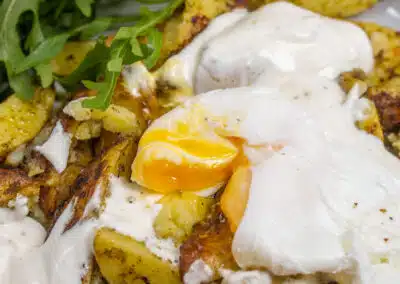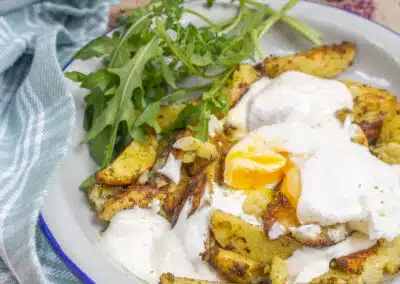Pesto-Kartoffelstampf mit pochiertem Ei
Kartoffelstampf ist ein wahrer Retter im Schub – egal ob CED, Reizdarm, Rheuma, Gastritis, Neurodermitis oder Psoriasis. In der Regel wird Kartoffelstampf sehr gut vertragen und enthält so viele tolle Nährstoffe wie beispielsweise resistente Stärke, die unsere Darmgesundheit fördern und Entzündungen entgegenwirken können. Aber – und das kennen wir alle – der Kartoffelstampf kann ganz schön langweilig werden und deshalb habe ich diese tolle Abwandlung für dich.
FRUKTOSEARM
LAKTOSEFREI
GLUTENFREI
HISTAMINARM
Kartoffelstampf ist ein wahrer Retter im Schub – egal ob CED, Reizdarm, Rheuma, Gastritis, Neurodermitis oder Psoriasis. In der Regel wird Kartoffelstampf sehr gut vertragen und enthält so viele tolle Nährstoffe wie beispielsweise resistente Stärke, die unsere Darmgesundheit fördern und Entzündungen entgegenwirken können. Aber – und das kennen wir alle – der Kartoffelstampf kann ganz schön langweilig werden und deshalb habe ich diese tolle Abwandlung für dich.
Zubereitung: 35 Minuten
Kalorien pro Portion: 420 kcal
Zutaten (für 2 Portionen):
-
300 g Kartoffel
-
2 EL Pesto
-
100 g laktosefreier, fettarmer Quark
-
2 Eier
-
1 EL Apfelessig
-
1 EL Saft aus einer Zitrone
-
Salz, Pfeffer
Zubereitung:
- Den Backofen auf 200°C Ober-/Unterhitze vorheizen.
- In der Zwischenzeit Kartoffeln waschen und (bei Bedarf) schälen, mit Pesto in einer ofenfesten Form marinieren. Ca. 30 Minuten im Ofen bei mittlerer Schiene backen.
- Quark, Zitronensaft, Salz und Pfeffer gründlich verrühren und nach Vorlieben würzen.
- Für das pochierte Ei, ca. 1 L Wasser in einem großen Topf mit Apfelessig aufkochen. Die Hitze etwas reduzieren, mit einem Kochlöffel kräftig umrühren und das Ei aus einer Tasse vorsichtig hineingleiten lassen. Das Ei ca. 3-4 Minuten kochen lassen.
- Die Ofenkratoffeln grob stampfen und mit Quark sowie dem pochierten Ei anrichten!
Bon Appetit!
Über mich

Hi! Mein Name ist Dominika. Ich bin Ernährungstherapeutin mit Vertiefung Ernährungspsychologie und ich begleite Menschen mit chronischen Darm- und Menstruationsbeschwerden auf ihrem Weg zur Balance.
Folge mir
Newsletter
& erhalte für 0€ mein E-Book

Frequently asked questions
I tried everything. But it is best not to eat at all. Do I take the strain off my gut?
I have no identified intolerances. Why do I still not tolerate fresh dairy products or fiber-rich foods?
Cabbage, beans or fiber are bloating. Is there anything I can do against it?
You may like these posts too
Folge mir auf
Datenschutz | AGB | Impressum | Kontakt




0 Kommentare